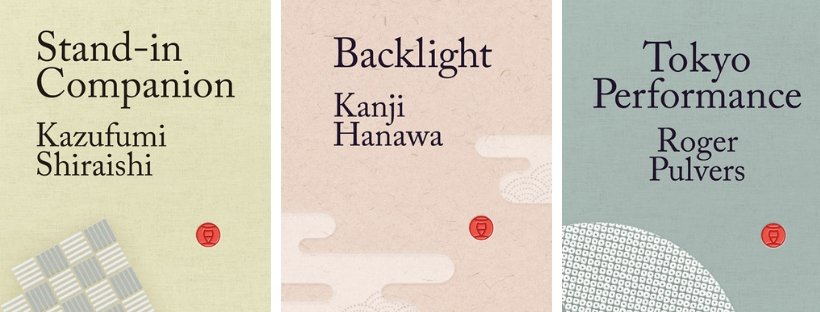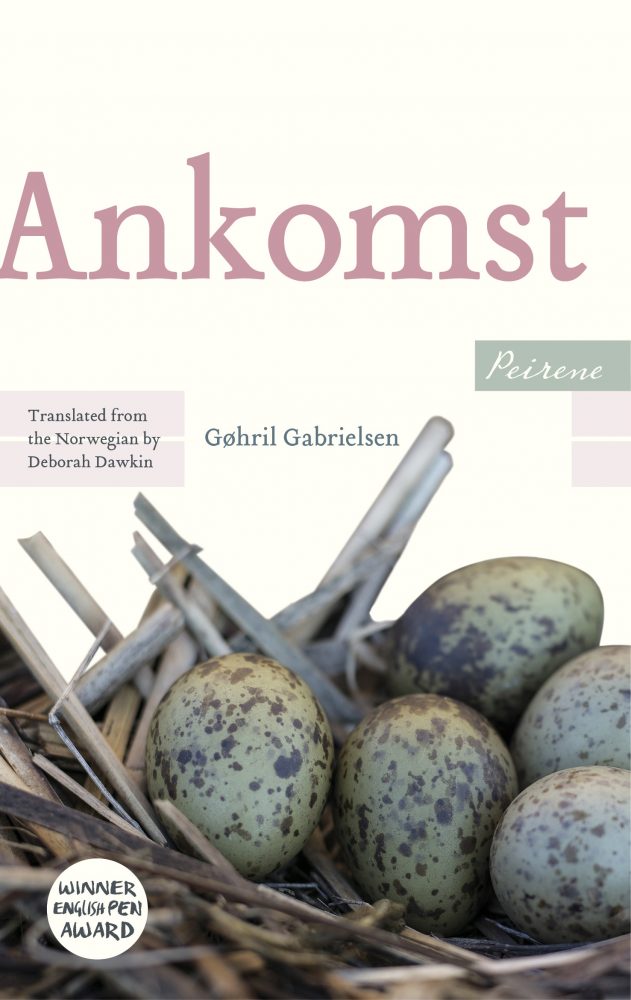Nobody does horror like Junji Ito, and there is no manga quite like a Junji Ito manga. While scary stories have been told for as long as we’ve had stories, and mythologies across the world are filled with creatures and tales of terror, it’s only within the last century that horror has become cemented as a genre.
When we think of that genre, the very familiar names of English language writers instantly come to mind: Stephen King, Shirley Jackson, James Herbert etc. But none of these writers capture the true feeling of terror like a Junji Ito manga can.
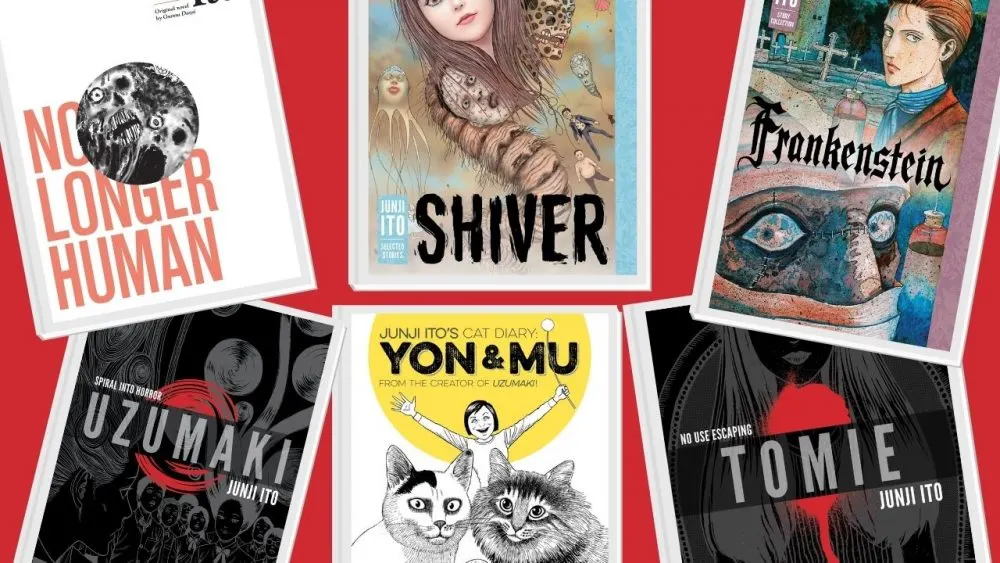
What sets the manga stories of Junji Ito apart from those of so many other horror writers is his understanding of phobias and of the unknown. There is a Lovecraftian flavour to Ito’s work, as well as inspiration lifted from Japanese folklore. But these are mere ingredients; the oven of Ito’s mind is what bakes them together into something wholly and uniquely frightening.
Junji Ito is a master of horror in more ways than one. He is a mangaka who has master creeping terror, monstrous horror, and quiet paranoia. He feeds on our phobias and the fears we don’t talk about. Junji Ito’s manga makes readers afraid of the things we didn’t know could be feared.
Ito makes nightmares out of ordinary things, and that’s at the core of his uncanny imagination. That and his masterful ability to draw the human form in twisted, broken, transformed ways. He does body horror better than anyone else in the genre.
Let’s put some substance to all this gushing over Junji Ito manga by looking at the man, his inspirations, his method, and — most importantly — the best Junji Ito manga available (and why it’s the best). If you’re a horror fan or a manga fan (or both) and you’re wondering where to start reading Junji Ito, or simply why readers hold his works in such high regard, you’ll find that out here.
Who is Junji Ito?
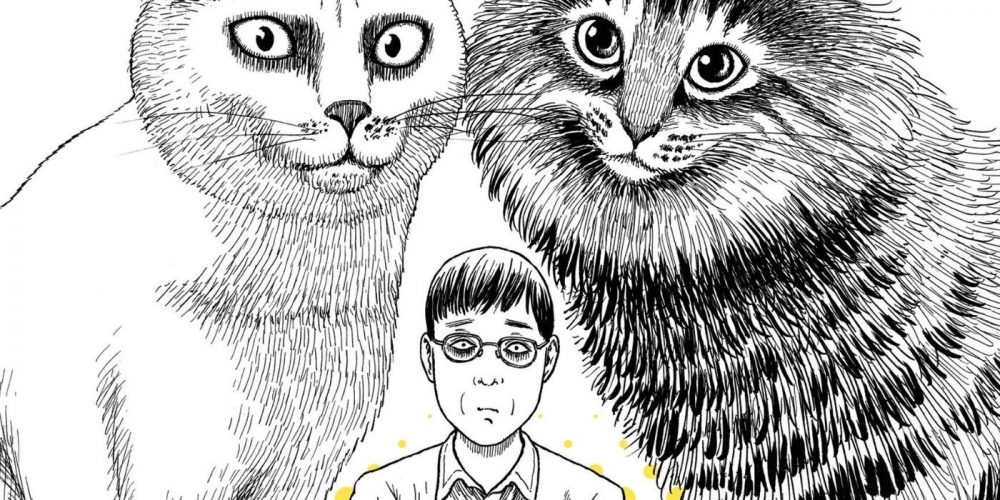
Inside and outside of his home country, Junji Ito’s manga is celebrated as the best of Japanese horror writing. While Japan has a strong history of crime and mystery writing, as well as horror writing, Junji Ito still stands head-and-shoulders above the rest.
Ito was born in Gifu prefecture in 1963. His debut horror book — which we’ll discuss below — was Tomie. This horror manga was published when Ito was only 24 and, despite it being his debut publication, it remains one of his most popular manga.
Unlike other popular Japanese writers like Haruki Murakami, whose debut works are often overlooked today, Ito’s earlier works are still treasured. Everything that Ito publishes is in the form of manga which he writes and draws himself.
Even the Junji Ito manga that doesn’t fit neatly into the horror genre still has elements of the uncanny and the unsettling in its illustration. That’s Ito’s style, and it’s what sets him apart from the rest. Here’s a writer that lives and breathes horror and terror.
Before becoming a full-time writer, and during the writing and release of Tomie, Junji Ito worked as a dental assistant. It took a little more time before he was able to break free of the 9-5 grind and dedicate his time, efforts, and imagination fully to his manga creation.
Speaking of imagination, Junji Ito’s influence stretches from other horror manga legends like Kazuo Umezu, author of the infamous Orochi: Blood, all the way to the previously mentioned originator of eldritch horror literature H.P. Lovecraft.
After reading such Junji Ito manga stories as The Thing That Drifted Ashore and The Enigma of Emigara Fault, the Lovecraft influence can be seen as clear as day. Both of these horror legends share an uncanny approach to the impossible, the unknowable, the otherworldly.
There’s a sense that these writers dare to describe what should never be described. What takes Junji Ito’s manga one step beyond even the stories of H.P. Lovecraft is that he dares to draw them as well as write them. The fact that Ito is a mangaka is the at the core of his uniqueness and his ability to stand out.
While his stories of terror share much in common with Lovecraft, Umezu, and even writers like Kobo Abe and Stephen King, it’s Ito’s distinct ability to bring what he imagines to life in staggering, chilling detail. Through Junji Ito’s manga, he forces us to confront the demons of his imagination, and it seems like he enjoys it.
Read More: Essential Horror Manga
Junji Ito Manga Books
Junji Ito manga comes in three distinct forms. The first is his longform graphic novels. These are longer stories that tell extended, interconnected horror stories. The second is his adaptations. In recent years, Ito has chosen to (or possible been asked to) adapt a handful of classic novels by Japanese and Western writers from prose into manga.
In this selection of Junji Ito books, we’ll cover the first two forms of Junji Ito manga. In the next selection, we’ll cover his third form: Ito’s best manga short stories, and where you can read them.
Sensor

Junji Ito has always leaned into the Lovecraftian method of world-building and storytelling, but never with so much gusto as in the brilliant Sensor. This is a 200-page love letter to H.P. Lovecraft (minus the racism).
Beginning with an unnatural natural phenomenon (golden volcanic hair falling like real hair onto a village), Sensor quickly spirals into a world of religious cults, telepaths, time travel, and unknowable cosmic beings. Junji Ito’s Sensor is more Lovecraft than Lovecraft.
In Sensor‘s first chapter, Kyoko Byakuya finds herself at the foot of Mount Sengoku, amidst the gentle falling of golden volcanic hair. She meets a man who knows her name, and who invites her to his village. She learns about the Christian missionary Miguel, whom the villagers protected during Japan’s prosecution of Christians.
After the shocking events of this chapter, Sensor shifts perspective to an unremarkable freelance reporter who is drawn to Byakuya’s story. Through his eyes, we watch the rest of Sensor unfold, as cults and cosmic horrors rise to the surface. The volcano, the hair, the Christian missionary, the village — all of it twists and merges in unexpected ways.
Sensor makes strong use of the twisted images and body horror that Junji Ito is best known for, but it does so sparingly. He saves the most shocking visual impacts for when they will hit hardest, or when they will best help to reinforce the insane twists and turns that Sensor repeatedly delivers.
There is one particular chapter which involves a strange bug. This headless thing with a swollen body and long antennae is grotesque, but it becomes more-so as the chapter progresses. The detailed gore that Ito draws so well is in full force at this moment. Also in the usual Ito style, his way of drawing facial expressions and emotions is consistently outstanding in Sensor.
We are so involved in the lives of these characters in part because of the bond we form through their expressions. Nobody draws the human face quite like Junji Ito.
Uzumaki
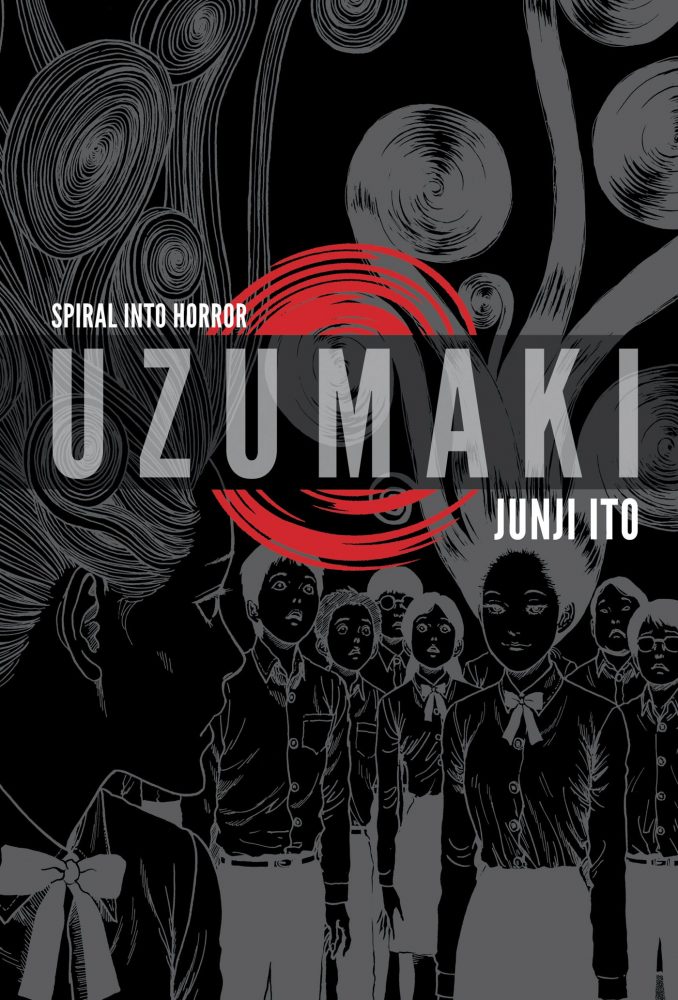
The Uzumaki manga is arguably Junji Ito’s most famous book, apart from a select handful of his short stories (found below). Originally published in three volumes and now available in a single collection, Uzumaki is a staggering work of horror fiction.
The name Uzumaki literally translates to ‘spiral’ and that is exactly what the story is about. Junji Ito manga is often defined by one single idea. That idea is then latched onto and developed (or, rather, morphed and twisted) into a terrifying threat.
From greasy skin to holes in rocks and marionette dolls, Ito is a master of taking one single idea and following it to some very dark and monstrous places. And in the Uzumaki manga, that idea is a spiral. The story of Uzumaki takes place in a fog-covered fictional Japanese town called Kurozu-cho (literally Black Vortex Town).
This town is affected by a curse involving the symbol of a spiral. It’s a story that plays on the impact that symbols have in both modern and ancient societies, especially in Japan. Uzumaki follows a young couple — Kirie and Shuichi — as they witness other townspeople fall victim to the curse of the spiral.
This curse builds up a mind-shattering state of paranoia and obsession that, eventually, leads to death. This is a Junji Ito manga that so vividly pays homage to the Lovecraft school of horror: this impossible, unknowable thing that renders innocent people insane and, even, dead.
Read More: Mieruko-chan is a must-read horror manga
Remina
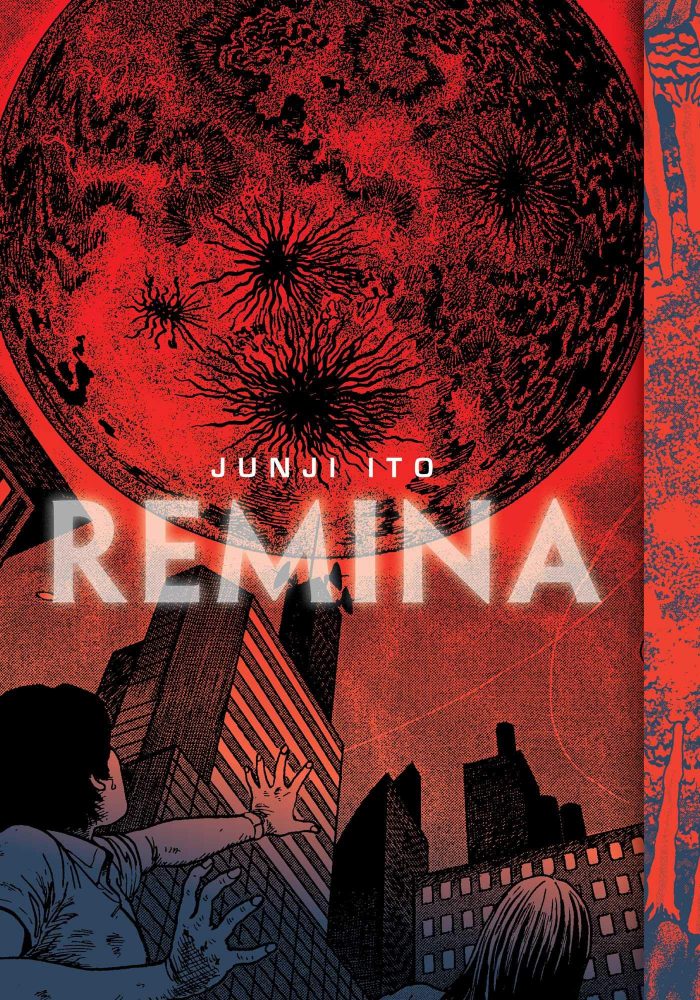
It’s no secret that Junji Ito’s writing, art, and, design style have all been heavily influenced by the mind and works of H.P. Lovecraft. Ito’s manipulation and contortion of the human body into something impossible and monstrous is his most infamous skill as an artist.
One aspect of Lovecraft’s style that has been less thoroughly explored, however, is the cosmic side of cosmic horror. Though one good example is The Thing That Drifted Ashore (below). Remina fills in this gap by bringing us cosmic horror on an enormous scale. This Junji Ito manga tells the story of a scientist, Dr. Oguro, who discovers a new planet that has suddenly appeared via a wormhole.
He names the planet after his daughter, Remina, before quickly noticing that Remina (the planet) is heading for Earth). The planet Remina is an entirely unknown entity; it seems to be alive, conscious, devouring planets and everything else on its way to Earth.
Remina the girl soon becomes famous, then feared, as conspiracy takes hold of the people and they speculate that the planet is headed for its namesake. The book deals with impossible, unstoppable cosmic horror and the very real horror of conspiracy and mania on the ground.
Ito’s art is on top form here, designing a planet that looks diseased, alive, and monstrous. This Junji Ito manga is vaguely reminiscent of the outstanding cosmic horror comic masterpiece by Grant Morrison and Chris Burnham: Nameless.
If you’re a fan of H.P. Lovecraft and Grant Morrison, or you want to see what the mind of Junji Ito does with science fiction cosmic horror, Remina is a must-read Junji Ito book.
Tomie
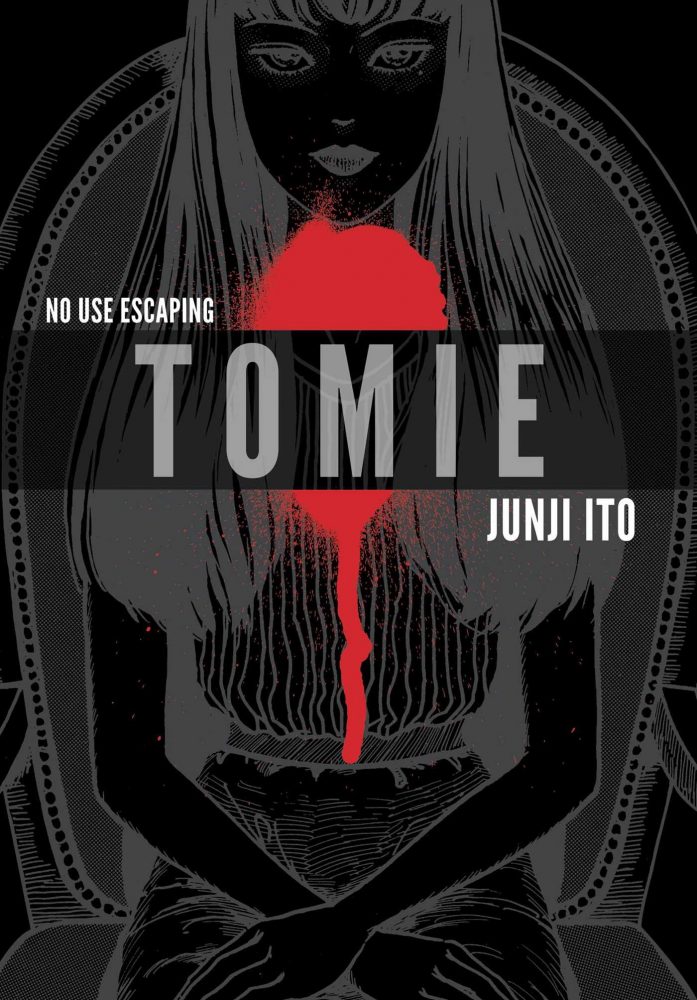
Junji Ito’s first ever published manga remains a very highly celebrated and frequently-read book. It’s also perhaps his most traditional and knowable horror story. Tomie is more grounded and less rooted in the impossible, otherworldly, Eldritch terror of his later stories.
The titular Tomie is a succubus: a beautiful young seductress who, no matter how often she is killed, returns to repeat this cycle of seduction and death. Tomie has a habit of seducing men who are eventually driven to murder. Despite Tomie herself often being their chosen victim, she eventually returns to wreak havoc once more.
Even this short synopsis makes it clear that this is a more traditional monster-horror story from Junji Ito. Written at the young age of twenty-four, it represents his horror beginnings and is still a very worthwhile read, though it certainly doesn’t represent his fully-developed horror imagination.
Junji Ito’s Cat Diary: Yon & Mu
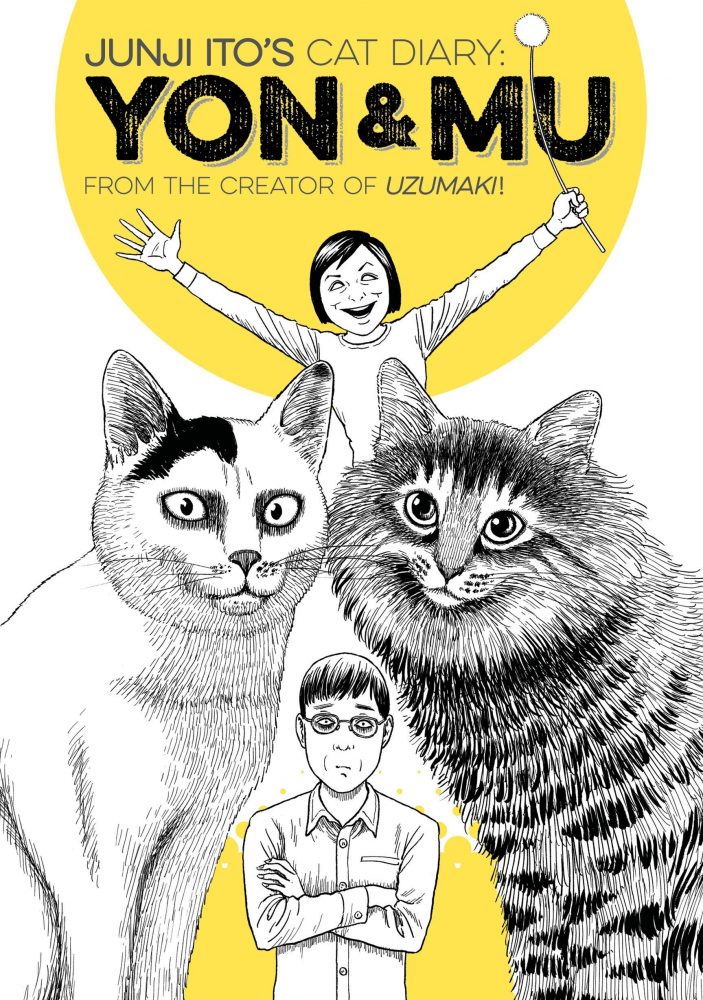
This is a very unique book amongst the Junji Ito manga oeuvre. For that reason, it isn’t the ideal place to start reading Junji Ito, but it is a fantastic read for fans of his horror manga. Junji Ito’s Cat Diary is unique within his body of work for several reasons. First: it’s a piece of narrative nonfiction. Or perhaps autofiction is a better term? Or, as the name outright states, a diary.
Ito is a fiction writer, first and foremost, so having something that is personal nonfiction feels delightfully special and intimate. Another reason that Junji Ito’s Cat Diary is so unique is that it is one of the most unique uses of Ito’s own imagination and approach to horror art.
That’s because this manga is not horror. Instead, it uses his eerie and unsettling approach to drawing as a way to add comedy to a true and grounded story. Put simply, Junji Ito’s Cat Diary is a short book about Ito’s very real personal experience with becoming the sudden owner of two cats: Yon and Mu.
These cats are now his responsibility and his housemates. His wife insisted that they get two cats, and now Ito must learn to live with them. It’s an ordinary tale; the kind of thing that has happened to many of us (when I lived in Shanghai, my partner one day brought home two tiny terrapins she had rescued. Suddenly, they were our responsibility).
But it’s through his creepy, eerie, unsettling approach to horror that this ordinary story becomes funny. In an uneasy and nervous kind of way. The way Ito draws himself, his wife, and the cats makes them all seem like characters in a horror story. And yet, nothing frightening is happening.
Depicting the ordinary with a horror approach somehow arrives at a place of unexpected comedy. It’s something you wouldn’t expect and, yet, it works. It works so very well.
Frankenstein
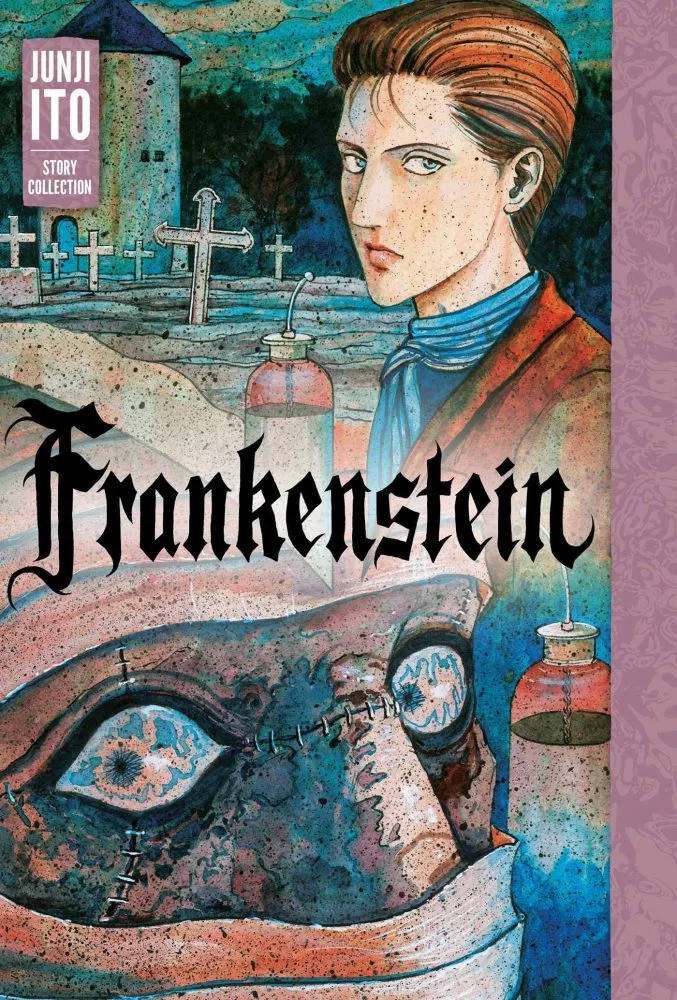
When this book was released, it was a very exciting day for me. Junji Ito is my favourite mangaka and Mary Shelley’s Frankenstein is my favourite novel. Having the latter be adapted into a manga by the former was like a dream come true.
I’ve read this book multiple times and, as a Frankenstein obsessive, I’m happy to say that it stands shoulder-to-shoulder with Danny Boyle’s stage adaptation as the best interpretation of Shelley’s original novel.
While Ito’s styles of storytelling and drawing are far removed from Shelley’s writing and themes, the two still managed to marry very successfully. Ito shows a little self-restraint here when it comes to his monstrous depictions of horror, but his unique style still shines through.
Junji Ito’s Frankenstein feels like a film adaptation of sorts, with Ito playing the role of director, costume designer, set designer, choreographer, and camera operator. And, in all of those roles, he excels. Adapting Frankenstein faithfully and originally is no small ask, but Ito answered the call with grace and poise, as well as a manic adoration for the source material.
It’s clear here that Ito adores Frankenstein and I love him all the more for that, and for adapting it to manga so spectacularly.
No Longer Human
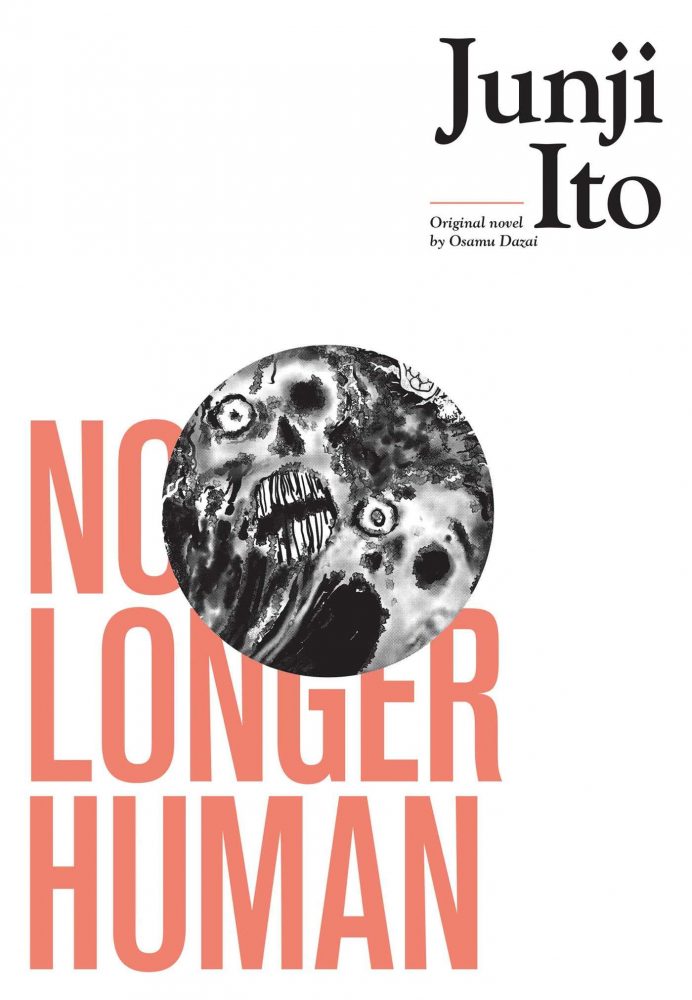
Osamu Dazai’s name is often mentioned in the same breath as those of other 20th Century Japanese writers like Yasunari Kawabata, Kenzaburo Oe, and Junichiro Tanizaki. As a brief member of the Japanese Communist Party, Dazai could be seen as the anti-Mishima. His legacy as a wartime writer and post-war author is legendary, and No Longer Human is often touted as his masterpiece.
No Longer Human has had a staggering influence on not only the Japanese canon, but also the works of writers like Qiu Miaojin and many other Korean and Taiwanese authors. When Dazai took his own life, he left behind a baby daughter, Yūko Tsushima and she grew up to be a famed author in her own right, having penned novels such as Territory of Light and Woman Running in the Mountains.
Dazai’s influence on Ito is apparent not only through the very existence of this manga adaptation, but also for the fact that Tomie Yamazaki — a woman with whom Dazai famously ran away from his wife and family, and who later committed suicide by drowning alongside Dazai — shares her name with Ito’s first manga publication.
No Longer Human is a novel inspired by Dazai’s own life, experiences, and behaviours. It shows us a man who feels as though he exists outside of the human experience.
When Ito’s manga adaptation of No Longer Human was published, it actually received a grander fanfare from fans than did his adaptation of Frankenstein. Fans argued that Ito’s style of drawing was better suited to the raw burn of Dazai’s storytelling.
If you’ve been interested in the work of Osamu Dazai, Ito’s adaptation is a fine place to begin. It blends the soreness of Dazai’s writing with Ito’s own uncanny and unsettling art masterfully. What you’re getting here is the best of both worlds: Dazai’s original story with new life breathed into it through the art of Junji Ito.
Junji Ito Manga Short Stories
While Junji Ito’s graphic novels and adaptations are worthy of celebration, it’s in his manga short stories where that Ito spark of imagination really catches fire. This reminds me of Stephen King, whose lesser-talked-about short horror stories are far smarter and more frightening than any of his novels.
Almost all of these Junji Ito manga short stories can be read in his magnum opus Shiver, a collection of Ito stories that is near perfect. Ito followed up on Shiver with Smashed and, unfortunately, none of the stories in Smashed can be found here because they simply don’t measure up to the quality of imagination on display in Shiver.
Since the publication of Smashed, we also now have Deserter, a collection of Junji Ito manga from his earlier days as a rising star. If you’re looking for a definitely place to start reading Junji Ito manga, turn first to Shiver, before moving onto Smashed and Deserter. Here are some of Ito’s best manga short stories.
Hanging Balloons
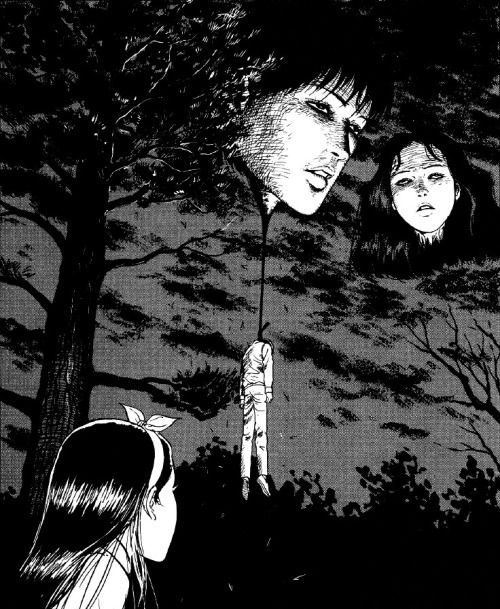
Found in the Shiver short story collection, Hanging Balloons is my personal favourite Junji Ito story. This manga represents Ito at his peak in more than one way. This is his imagination working in remarkable ways. It also best showcases his uncanny ability to draw the human face in the most terrifyingly expressive ways.
While other stories (see below) showcase even more bonkers imaginative flexing than this one, Hanging Balloons is arguably Ito’s most unsettling and outright horrifying manga short story. Hanging Balloons tells the story of Japan as it is quickly and quietly invaded by enormous balloons.
Each of these balloons is uniquely tailored to a specific person, sharing their exact face and hair. Everyone has a balloon, and everyone’s balloon is after them. When your balloon finds you, it loops a noose around your necks and strangles you. Soon enough, Japan’s skies is as filled with balloons dragging along dead bodies as it is with balloons still hunting their prey.
The premise is terrifying enough, but the horror comes from several places. The concept of a silent yet enormous hunter, and the innocent people trying to evade them, makes for an adrenaline rush of a story. And Ito’s depiction of gaunt, dead faces on these drifting, lifeless balloons really tips this into the uncanny valley.
Madonna
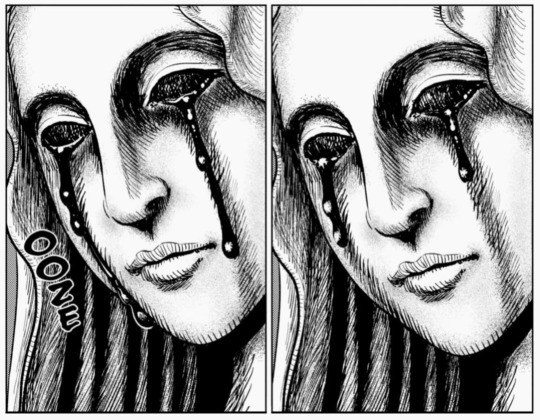
Madonna is the second story from Junji Ito’s The Liminal Zone; a collection of four standalone tales that were unrestrained by the magazine format and therefore as long as he wanted them to be. All four of the tales in The Liminal Zone are worth reading, but Madonna stands out as something unique thanks to its leanings on Western religious horror and guilt.
Many of Ito’s tales are inspired by Japanese folklore and tradition (Weeping Woman Way and The Spirit Flow of Aokigahara are two great examples, both found in The Liminal Zone). Madonna, however, leans hard on the concept of catholic guilt, religious fervour, doctrine, and a the cult mentality of Western churches.
It tells the story of a private girls’ school, lorded over by a principal and his wife, a woman who believes herself the Virgin Mary reincarnate. Our protagonist, a new girl at the school, becomes increasingly unnerved by the behaviours of certain students, by the fact that salt pours from their ears and one girl is seen licking a statue in the garden.
These rituals and behaviours begin to make a kind of sense as secrets surrounding the principal and his wife come to light. Along with these revelations, however, comes fear and danger.
It’s refreshing to see Ito flex his Lovecraftian muscles in a christian setting. The church is a scary world, rife with imagery and rituals that can be true nightmare fuel, and Junji Ito proves that with Madonna.
The Long Dream

This is another Ito short story that’s found in the Shiver collection. It’s also one of the very best Junji Ito manga to showcase his incredible approach to body horror. I haven’t talked about this much so far but it’s Ito’s ability to draw the human form in distorted, monstrous, broken ways that really makes him stand tall as a master of horror.
What makes the body horror of The Long Dream so unique is that it doesn’t come in the usual form of explosive and monstrous change (think werewolf transformations from old horror films). The Long Dream takes a slow and gradual approach to body horror, with its protagonist/victim confined to a hospital bed.
The central conceit behind this weird and wonderful Junji Ito manga is that our bedridden man lives for several years in a dream state every time he sleeps. He goes to bed and dreams of entire lives. When he wakes up, those dreamed years have added to his body’s physical age, thus rapidly turning his body into something completely unknowable: a thing that has aged thousands of years and yet is still alive.
It’s a chilling story that really shows off Ito’s talent for drawing bodies in a transformed state. Fun fact: When I was a kid watching Return of the Jedi, I thought that Yoda telling Luke that he was 900 years old meant that he was a human who happened to have lived for that long.
And since my grandmother had shrunk with age, and so had Yoda, any human who lived to 900 would eventually turn green and have elf-like ears. Yoda, child-me assumed, was just what we would all eventually look like if we managed to live to 900.
In a weird way, The Long Dream reminds me of that childhood misunderstanding, and also answers my question of what a person who had continued to age for hundreds of years might look like.
Earthbound
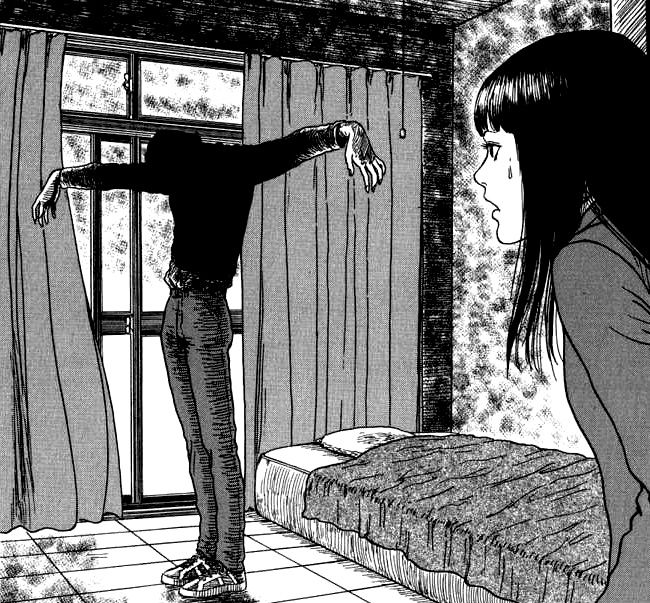
Found in the Smashed short story collection, Earthbound is a Junji Ito manga that really leans on the eeriness factor. While many of his stories rely on cosmic horror or body horror, this one is more of a slow, creeping dread. Earthbound begins, as many of Ito’s short stories do, with a phenomenon. People across Japan have randomly started standing in a single spot, getting stuck in a single pose, and barely speaking.
At first, people think it’s a performance piece, but then it gently turns from strange to frightening. When asked why, most of them plead, in a pathetic mumble, for the enquirer to leave them alone. But a charity has also been set up to provide them with comfort, food, and water; all of which the “earthbound” (or simply “bound”) choose to ignore.
The phenomenon spreads slowly, and people begin to wonder if it’s contagious. There is no rhyme or reason for why people would begin acting this way. Until, of course, there is. Earthbound is a Junji Ito manga with more than one twist. In fact, it twists and turns very quickly. Our protagonist is one of the charity volunteers, and even her personal life is subject to multiple unexpected twists.
There is no body horror here; no abstract terror. This is a story of slow, strange, creeping dread, demonstrating Junji Ito as a master of tension and dread.
Honoured Ancestors
This is another story found in Shiver. I should mention that one of the cool things about Shiver (as is common with many manga tankobon) is the inclusion of little notes and anecdotes from the author. They’re often about what inspired the story to begin with.
The anecdote for Honoured Ancestors is doubly fascinating because it explains how Ito thought the image of a person running on all fours backwards, in a spider-like fashion, was uncanny and unsettling. And he wanted to feature that into a story. Then he watched The Exorcist and felt deflated because the filmmakers had done it before he had the chance to.
However, in spite of that, Honoured Ancestors still stands tall as one of Ito’s coolest concepts for a horror manga short story. The story follows a teenage girl who is brought home to meet her potential boyfriend’s dad. Prior to doing this, she has been haunted by dreams of a giant caterpillar.
When she gets to the house, the boy’s father enters the room backwards in a spider-like fashion, while keeping the top half of his head obscured behind the door frame. The reason for this is revealed in the story’s twisted, climactic ending and it is a doozy that sends shivers down your spine. It’s another fantastic example of Ito’s playful, experimental, and masterful command of body horror in manga.
Fashion Model
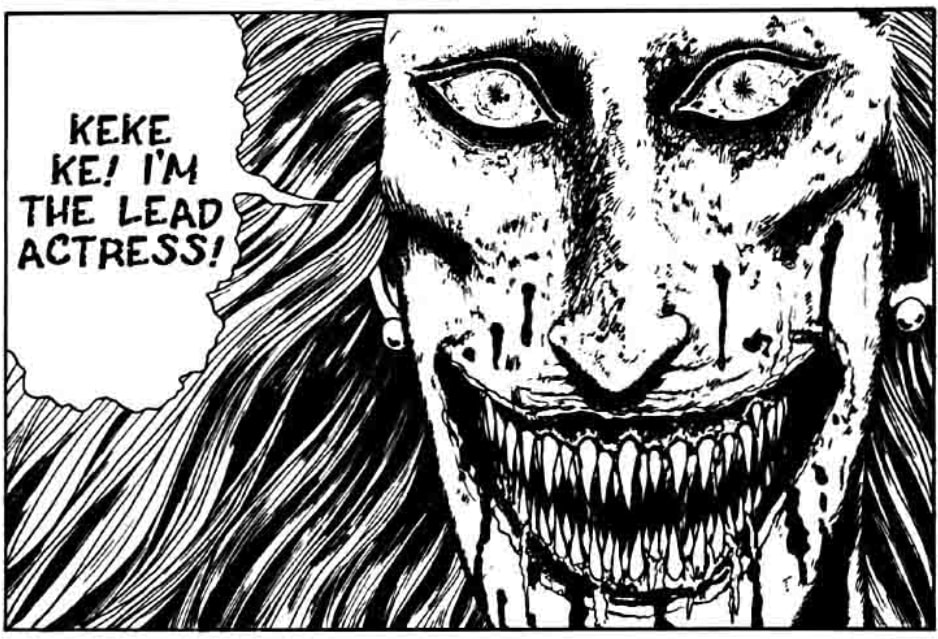
This is the last story on this list to feature in the Shiver short story collection. But that book is full of gems that really show off the strength of Ito’s art and plotting.
Fashion Model is the story that gave us one of Ito’s most iconic characters. When you Google Junji Ito, certain images take the centre stage: Tomie’s face, the Uzumaki spirals, and the fashion model: a predatory, monstrous looking woman with sharp teeth, long fingers, piercing eyes, and a hungry stare.
This is the story in which the fashion model originated, and she is exactly what you’d expect her to be. The story is told by a nervous and twitchy young man who is working with an amateur film crew. When the titular fashion model turns up to a day of filming, our protagonist is immediately frightened.
Since he is so scared and she looks so very obviously scary, doubt is immediately sewn into our minds about whether or not she is actually a threat. For a Junji Ito manga, after all, that would be far too predictable. It must be something else. Surely. Well, you’ll have to read the story to find out.
The Enigma of Amigara Fault

The final two stories in this list of Junji Ito manga can each be found in different places. This first story, The Enigma of Amigara Fault, can be read as a bonus final chapter in the book Gyo. If you’ve ever done a passive search for Ito, or if you’re already a big Ito fan, then you will have seen all the jokes and memes that have grown out of this story.
What’s so interesting about The Enigma of Amigara Fault is its lack of that patented Ito body horror (until the very last page, that is). There is nothing overtly grotesque or monstrous about this story. It’s all about the concept and the narrative.
In fact, it’s one of the few Ito short stories that would probably work just as well as prose rather than manga form. The Enigma of Amigara Fault begins with an earthquake so intense that it splits the ground and opens up a rift in the earth, raising a large section of rock several metres up above ground level.
That newly exposed face of rock reveals an enormous stretch of human-shaped holes like cookie cutters. The enigma draws public attention and news crews begin to report on it. Soon enough, people are coming from all over to see the human-shaped holes for themselves.
How did they get there? How long have they been there? Who carved them? How is that even possible when they were in the Earth’s crust? This is a story that plays on our fear of — and addiction to — the unknown and the seemingly impossible.
Soon enough, people start to find their own holes: a hole that they fit into perfectly. A hole that was carved out just for them. To find out what happens to these people, you’ll have to read The Enigma of Amigara Fault.
The Thing That Drifted Ashore
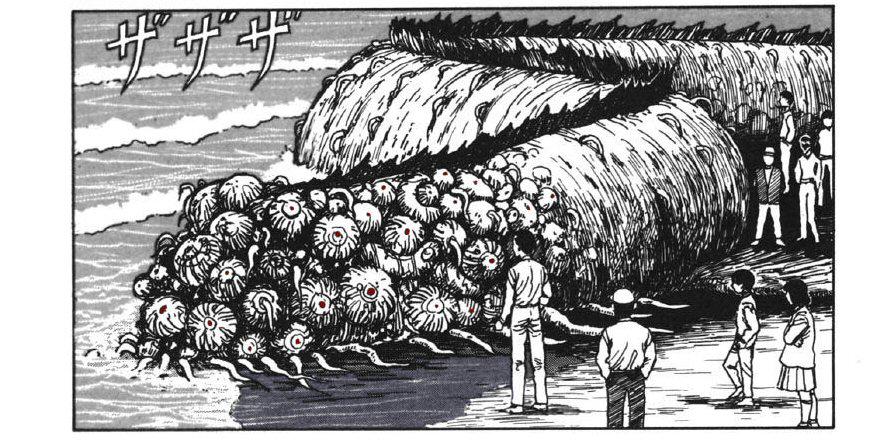
This is a story found in one of Ito’s earlier short story collections, known as the Slug Girl Collection (named after one of the book’s stories). Slug Girl is, however, a far less iconic tale than The Thing That Drifted Ashore.
If there is one Junji Ito manga that best encapsulates his Lovecraftian inspiration, it’s this one. Lovecraft understood just how vast and unknowable the spaces above and below us are. The depths of the ocean, the endless reaches of space, and even our planet’s remote and mysterious past.
Ito takes that Lovecraftian approach to the wide open unknown and runs with it in this story. The Thing That Drifted Ashore presents us with an enormous, impossible, strange creature. This creature has simply washed up on the shore one day, and people wonder what it is; where it came from; how it came to even exist. It’s a story that truly sparks the imagination.
Some of the best horror and monster stories tap into this idea of uncharted, unknown parts of time and space. The Thing That Drifted Ashore brings one of those unknown horrors into our familiar world and asks us to poke and prod at it.


